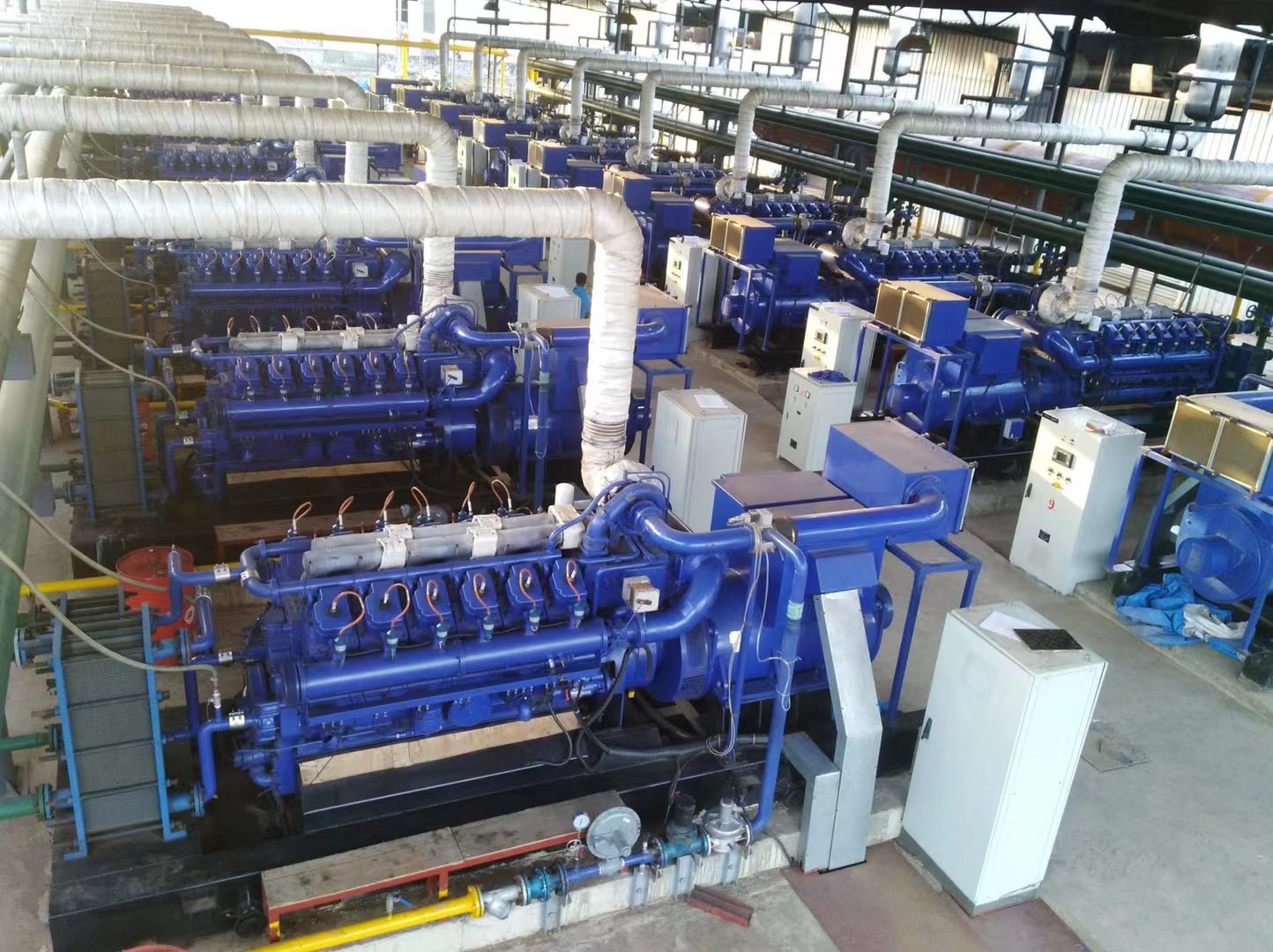在全球能源結(jié)構(gòu)加速調(diào)整�、環(huán)保要求日益嚴(yán)苛的時代背景下�����,尋求高效����、清潔且可靠的能源解決方案成為了焦點。燃?xì)獍l(fā)電機(jī)組作為一種融合了先進(jìn)技術(shù)與環(huán)保理念的發(fā)電設(shè)備����,正逐漸嶄露頭角�����,在能源領(lǐng)域發(fā)揮著愈發(fā)重要的作用��。它以天然氣�����、沼氣��、煤層氣等可燃?xì)怏w為燃料�����,通過一系列精密的機(jī)械與電氣轉(zhuǎn)換過程���,將化學(xué)能高效地轉(zhuǎn)化為電能,為工業(yè)生產(chǎn)�����、商業(yè)運營以及居民生活等諸多領(lǐng)域提供穩(wěn)定的電力支持����。?
In the context of accelerating global energy structure adjustment and increasingly stringent environmental requirements, seeking efficient, clean, and reliable energy solutions has become a focus. As a power generation equipment that integrates advanced technology and environmental protection concepts, gas-fired generators are gradually emerging and playing an increasingly important role in the energy field. It uses combustible gases such as natural gas, biogas, and coalbed methane as fuel, and efficiently converts chemical energy into electrical energy through a series of precise mechanical and electrical conversion processes, providing stable power support for many fields such as industrial production, commercial operations, and residential life. ?
基礎(chǔ)構(gòu)造與工作原理?
Basic structure and working principle
構(gòu)造解析?
Construct analysis
燃?xì)獍l(fā)電機(jī)組主要由燃?xì)獍l(fā)動機(jī)���、發(fā)電機(jī)�����、控制系統(tǒng)以及輔助設(shè)備等部分構(gòu)成���。燃?xì)獍l(fā)動機(jī)是整個機(jī)組的核心動力源�,其結(jié)構(gòu)設(shè)計與傳統(tǒng)的燃油發(fā)動機(jī)有相似之處���,但針對燃?xì)馊紵匦赃M(jìn)行了專門優(yōu)化��。發(fā)動機(jī)的氣缸�、活塞���、連桿等部件經(jīng)過特殊處理��,以適應(yīng)燃?xì)馊紵a(chǎn)生的高溫���、高壓環(huán)境,確保發(fā)動機(jī)的高效穩(wěn)定運行。例如����,氣缸內(nèi)壁采用特殊的耐磨涂層,提高其抗磨損能力�,延長發(fā)動機(jī)使用壽命。?
Gas generator sets are mainly composed of gas engines, generators, control systems, and auxiliary equipment. The gas engine is the core power source of the entire unit, and its structural design is similar to traditional fuel engines, but has been specifically optimized for the combustion characteristics of gas. The cylinder, piston, connecting rod and other components of the engine are specially treated to adapt to the high temperature and high pressure environment generated by gas combustion, ensuring the efficient and stable operation of the engine. For example, the inner wall of the cylinder is coated with a special wear-resistant layer to improve its wear resistance and extend the service life of the engine. ?
發(fā)電機(jī)則與燃?xì)獍l(fā)動機(jī)通過聯(lián)軸器緊密相連�,將發(fā)動機(jī)輸出的機(jī)械能轉(zhuǎn)化為電能。常見的發(fā)電機(jī)類型為同步發(fā)電機(jī)����,它由定子和轉(zhuǎn)子兩大部分組成。定子繞組產(chǎn)生感應(yīng)電動勢����,轉(zhuǎn)子則通過直流勵磁產(chǎn)生磁場,在發(fā)動機(jī)的帶動下高速旋轉(zhuǎn)�,使定子繞組不斷切割磁力線,從而產(chǎn)生交流電���。?
The generator is closely connected to the gas engine through a coupling, converting the mechanical energy output by the engine into electrical energy. The common type of generator is synchronous generator, which consists of two main parts: stator and rotor. The stator winding generates induced electromotive force, while the rotor generates a magnetic field through DC excitation, which rotates at high speed under the drive of the engine, causing the stator winding to continuously cut magnetic field lines and generate alternating current. ?
控制系統(tǒng)猶如燃?xì)獍l(fā)電機(jī)組的 “大腦”����,負(fù)責(zé)監(jiān)測和調(diào)控機(jī)組的運行狀態(tài)��。它通過各種傳感器實時采集發(fā)動機(jī)的轉(zhuǎn)速、溫度��、壓力以及發(fā)電機(jī)的電壓���、電流等關(guān)鍵參數(shù)����,并根據(jù)預(yù)設(shè)的程序和邏輯對這些參數(shù)進(jìn)行分析處理�。一旦發(fā)現(xiàn)運行參數(shù)偏離正常范圍����,控制系統(tǒng)會立即發(fā)出指令,調(diào)整發(fā)動機(jī)的燃油供給量�����、進(jìn)氣量或發(fā)電機(jī)的勵磁電流等����,以確保機(jī)組穩(wěn)定運行。例如����,當(dāng)發(fā)動機(jī)溫度過高時,控制系統(tǒng)會自動增加冷卻風(fēng)扇的轉(zhuǎn)速,加強散熱效果�����;當(dāng)電網(wǎng)電壓出現(xiàn)波動時��,控制系統(tǒng)會迅速調(diào)節(jié)發(fā)電機(jī)的勵磁電流���,穩(wěn)定輸出電壓����。?
The control system is like the "brain" of a gas generator set, responsible for monitoring and regulating the operating status of the unit. It collects key parameters such as engine speed, temperature, pressure, and generator voltage and current in real time through various sensors, and analyzes and processes these parameters according to preset programs and logic. Once the operating parameters deviate from the normal range, the control system will immediately issue instructions to adjust the fuel supply, intake, or excitation current of the engine or generator to ensure stable operation of the unit. For example, when the engine temperature is too high, the control system will automatically increase the speed of the cooling fan to enhance the heat dissipation effect; When the voltage of the power grid fluctuates, the control system will quickly adjust the excitation current of the generator to stabilize the output voltage. ?

輔助設(shè)備包括燃?xì)夤?yīng)系統(tǒng)�、冷卻系統(tǒng)、潤滑系統(tǒng)�、排氣系統(tǒng)等。燃?xì)夤?yīng)系統(tǒng)負(fù)責(zé)將清潔的燃?xì)饩_地輸送至發(fā)動機(jī)的燃燒室����,其關(guān)鍵部件如燃?xì)庹{(diào)壓閥、過濾器等����,能夠確保燃?xì)鈮毫Ψ€(wěn)定、雜質(zhì)去除�����,為發(fā)動機(jī)的高效燃燒提供保障。冷卻系統(tǒng)通過循環(huán)冷卻液帶走發(fā)動機(jī)運行過程中產(chǎn)生的大量熱量���,防止發(fā)動機(jī)因過熱而損壞�,常見的冷卻方式有水冷和風(fēng)冷兩種��。
Auxiliary equipment includes gas supply system, cooling system, lubrication system, exhaust system, etc. The gas supply system is responsible for accurately delivering clean gas to the combustion chamber of the engine. Its key components such as gas pressure regulating valves, filters, etc. can ensure stable gas pressure, remove impurities, and provide guarantees for efficient combustion of the engine. The cooling system removes a large amount of heat generated during engine operation by circulating coolant, preventing engine damage due to overheating. Common cooling methods include water cooling and air cooling.
This article is a friendly contribution from a gas generator set For more information, please click on: Sincere Attitude To provide you with comprehensive services We will gradually contribute more relevant knowledge to everyone Coming soon.
 聯(lián)系 - 熱線
聯(lián)系 - 熱線

 聯(lián)系 - 熱線
聯(lián)系 - 熱線


 咨詢電話:0531-69953988
咨詢電話:0531-69953988 公司地址:中國(山東)自由貿(mào)易試驗區(qū)濟(jì)南片區(qū)孫村街道經(jīng)十東路33688號章錦綜合保稅區(qū)聯(lián)東U谷科創(chuàng)中心5號樓101
公司地址:中國(山東)自由貿(mào)易試驗區(qū)濟(jì)南片區(qū)孫村街道經(jīng)十東路33688號章錦綜合保稅區(qū)聯(lián)東U谷科創(chuàng)中心5號樓101

